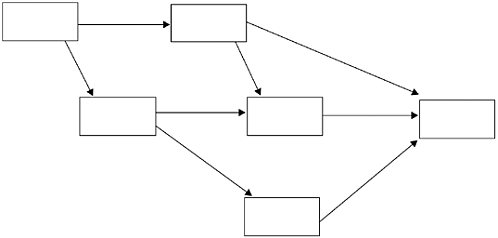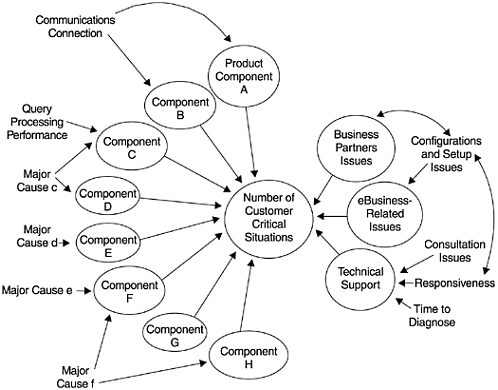Relations Diagram
Ishikawa's seven basic tools are also called the seven old tools or the seven quality control tools. In recent years there emerged the seven new quality planning and management tools, which are the affinity diagram, the relations diagram, the tree diagram, the matrix chart, the matrix data analysis chart, the process decision program chart (PDPC), and the arrow diagram. Although discussion of these seven new tools is not in the scope of this book, it would be remiss not to mention that they may also be useful in software engineering. These seven new tools are mostly qualitative and seem more appropriate for project management and structural brainstorming. Rudisill (1992) reports that a large software development company has automated these seven new tools to facilitate the quality function deployment approach in software development and has gained positive experience, especially in gathering and verifying customers' requirements.
One of the seven new tools that we found very useful over the years is the relations diagram. It displays complex relationships and fosters cause-and-effect thinking. It organizes information from specific to general and surfaces key causes and key effects. It differs from the cause-and-effect diagram in that it displays multiple causes and effects, whereas the cause-and-effect diagram shows one dependent variable (effect) and its cause structure. Figure 5.17 shows a schematic representation of the relations diagram.
Figure 5.17. A Schematic Representation of a Relations Diagram

Figure 5.18 shows a loosely constructed relations diagram (which is somewhat different from the schematic representation in form). It displays the complex cause-and-effect relationships among the factors contributing to the number of customer critical situations for a software product. In this example, a critical situation occurred when a customer's business operations were affected because of issues related to this software product and the customer filed a complaint to the organization that provided the software. The issues could be product quality, the severity and impact of specific defects, technical support issues, ways-of-doing business issues (e.g., e-business issues ”business issues related to Internet and this software), and even issues related to business partners .
Figure 5.18. A Diagram of Complex Relationships Associated with Customer-Critical Situations of a Software Product

We found the relations diagram very appealing for complex situations like this example. It is flexible and it fits naturally with the small-team brainstorming process in problem identification and problem solving. In fact, the initial form of the diagram in Figure 5.18 was simply the result of a brainstorming session that was captured on a white board. The final form was the cumulative result of subsequent brainstorming sessions, interviews, further analysis, and verifications. The relations diagram can also be supported by quantitative data analysis. For example, the varying sizes of the circles of product components in Figure 5.18 reflect the relative contributions of these components to the number of customer critical situations. For interested experts, multivariate statistical analysis can also be performed to quantify the relationships in a relations diagram because applicable statistical techniques exist. For example, the structural equation models, or path analysis, appear to match well with the relations diagram. Even the two-way relationships among the factors in a relations diagram can be modeled via the recursive structural equation techniques (Duncan, 1975).
What Is Software Quality?
Software Development Process Models
- Software Development Process Models
- The Waterfall Development Model
- The Prototyping Approach
- The Spiral Model
- The Iterative Development Process Model
- The Object-Oriented Development Process
- The Cleanroom Methodology
- The Defect Prevention Process
- Process Maturity Framework and Quality Standards
Fundamentals of Measurement Theory
- Fundamentals of Measurement Theory
- Definition, Operational Definition, and Measurement
- Level of Measurement
- Some Basic Measures
- Reliability and Validity
- Measurement Errors
- Be Careful with Correlation
- Criteria for Causality
Software Quality Metrics Overview
- Software Quality Metrics Overview
- Product Quality Metrics
- In-Process Quality Metrics
- Metrics for Software Maintenance
- Examples of Metrics Programs
- Collecting Software Engineering Data
Applying the Seven Basic Quality Tools in Software Development
- Applying the Seven Basic Quality Tools in Software Development
- Ishikawas Seven Basic Tools
- Checklist
- Pareto Diagram
- Histogram
- Run Charts
- Scatter Diagram
- Control Chart
- Cause-and-Effect Diagram
- Relations Diagram
Defect Removal Effectiveness
- Defect Removal Effectiveness
- Literature Review
- A Closer Look at Defect Removal Effectiveness
- Defect Removal Effectiveness and Quality Planning
- Cost Effectiveness of Phase Defect Removal
- Defect Removal Effectiveness and Process Maturity Level
The Rayleigh Model
- The Rayleigh Model
- Reliability Models
- The Rayleigh Model
- Basic Assumptions
- Implementation
- Reliability and Predictive Validity
Exponential Distribution and Reliability Growth Models
- Exponential Distribution and Reliability Growth Models
- The Exponential Model
- Reliability Growth Models
- Model Assumptions
- Criteria for Model Evaluation
- Modeling Process
- Test Compression Factor
- Estimating the Distribution of Total Defects over Time
Quality Management Models
- Quality Management Models
- The Rayleigh Model Framework
- Code Integration Pattern
- The PTR Submodel
- The PTR Arrival and Backlog Projection Model
- Reliability Growth Models
- Criteria for Model Evaluation
- In-Process Metrics and Reports
- Orthogonal Defect Classification
In-Process Metrics for Software Testing
- In-Process Metrics for Software Testing
- In-Process Metrics for Software Testing
- In-Process Metrics and Quality Management
- Possible Metrics for Acceptance Testing to Evaluate Vendor-Developed Software
- How Do You Know Your Product Is Good Enough to Ship?
Complexity Metrics and Models
- Complexity Metrics and Models
- Lines of Code
- Halsteads Software Science
- Cyclomatic Complexity
- Syntactic Constructs
- Structure Metrics
- An Example of Module Design Metrics in Practice
Metrics and Lessons Learned for Object-Oriented Projects
- Metrics and Lessons Learned for Object-Oriented Projects
- Object-Oriented Concepts and Constructs
- Design and Complexity Metrics
- Productivity Metrics
- Quality and Quality Management Metrics
- Lessons Learned from OO Projects
Availability Metrics
- Availability Metrics
- 1 Definition and Measurements of System Availability
- Reliability, Availability, and Defect Rate
- Collecting Customer Outage Data for Quality Improvement
Measuring and Analyzing Customer Satisfaction
- Measuring and Analyzing Customer Satisfaction
- Customer Satisfaction Surveys
- Analyzing Satisfaction Data
- Satisfaction with Company
- How Good Is Good Enough
Conducting In-Process Quality Assessments
- Conducting In-Process Quality Assessments
- The Preparation Phase
- The Evaluation Phase
- The Summarization Phase
- Recommendations and Risk Mitigation
Conducting Software Project Assessments
- Conducting Software Project Assessments
- Audit and Assessment
- Software Process Maturity Assessment and Software Project Assessment
- Software Process Assessment Cycle
- A Proposed Software Project Assessment Method
Dos and Donts of Software Process Improvement
- Dos and Donts of Software Process Improvement
- Measuring Process Maturity
- Measuring Process Capability
- Staged versus Continuous Debating Religion
- Measuring Levels Is Not Enough
- Establishing the Alignment Principle
- Take Time Getting Faster
- Keep It Simple or Face Decomplexification
- Measuring the Value of Process Improvement
- Measuring Process Adoption
- Measuring Process Compliance
- Celebrate the Journey, Not Just the Destination
Using Function Point Metrics to Measure Software Process Improvements
- Using Function Point Metrics to Measure Software Process Improvements
- Software Process Improvement Sequences
- Process Improvement Economics
- Measuring Process Improvements at Activity Levels
Concluding Remarks
- Concluding Remarks
- Data Quality Control
- Getting Started with a Software Metrics Program
- Software Quality Engineering Modeling
- Statistical Process Control in Software Development
A Project Assessment Questionnaire
EAN: 2147483647
Pages: 176
